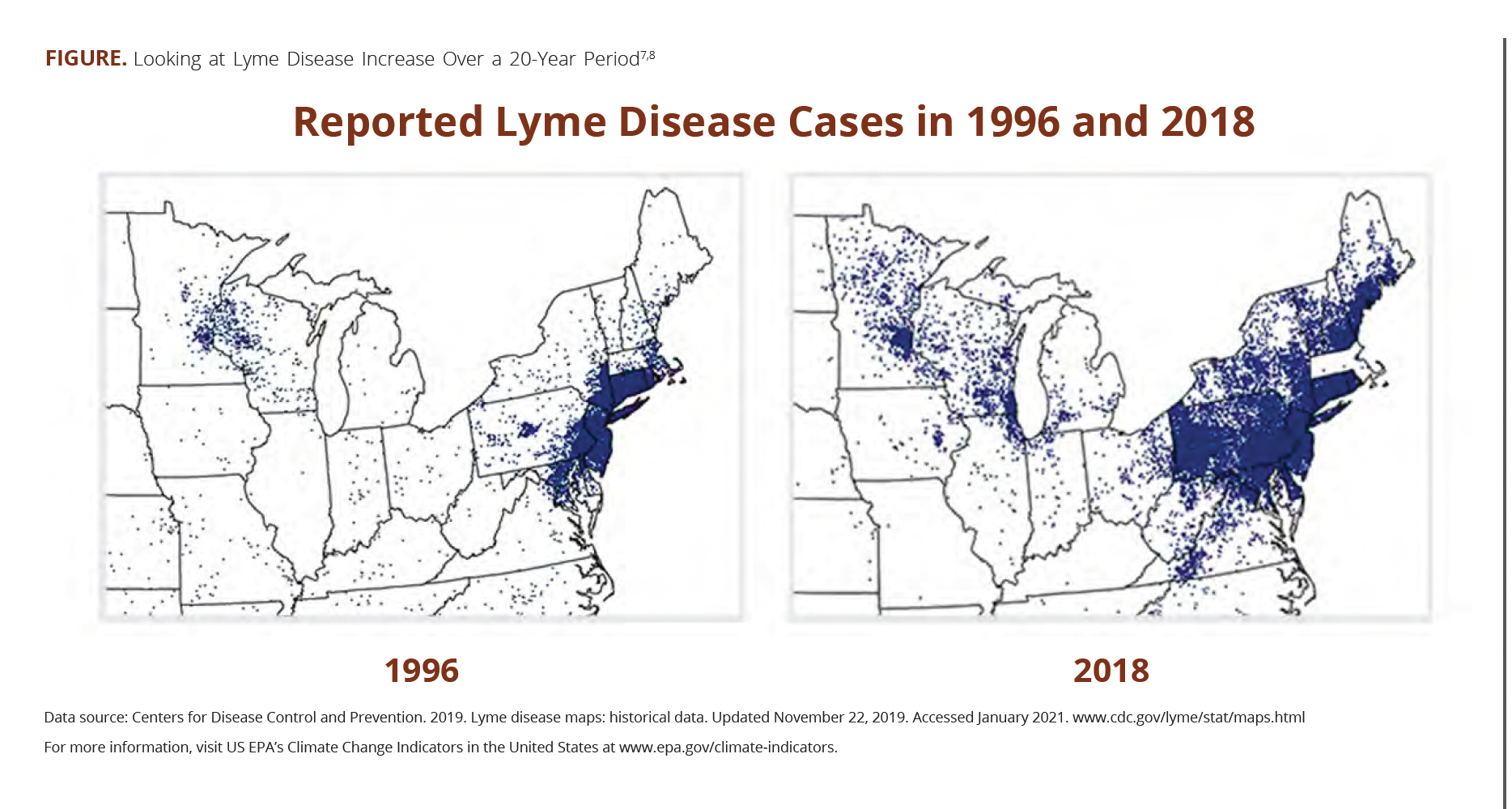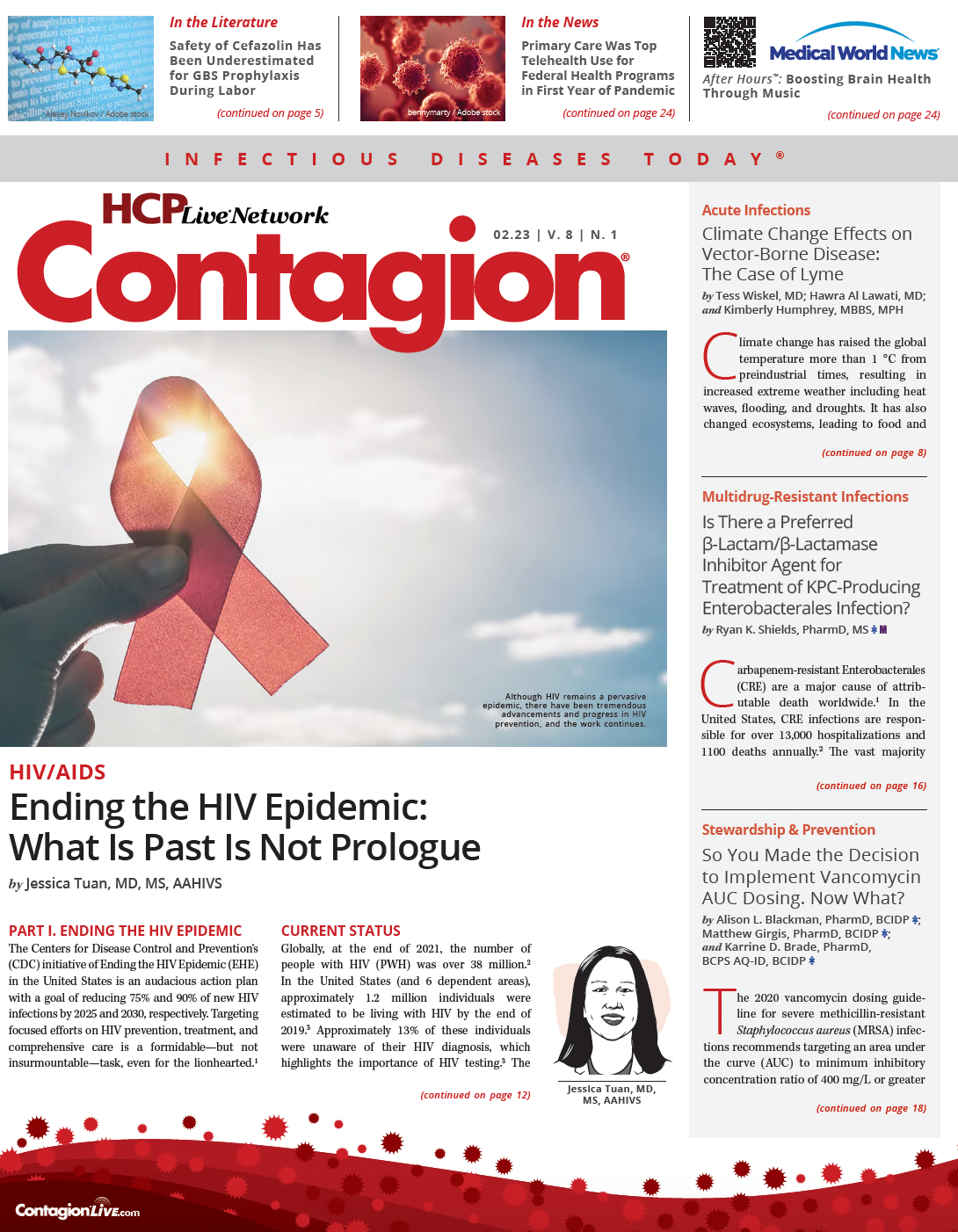Climate Change Effects on Vector-Borne Disease: The Case of Lyme
With evolving weather patterns, the natural habitat of ticks is expanding, and more people are becoming susceptible to them.
Climate change has raised the global temperature more than 1 °C from preindustrial times, resulting in increased extreme weather including heat waves, flooding, and droughts. It has also changed ecosystems, leading to food and water insecurity.1 In turn, this had a broad impact on a range of human diseases, from heat stroke and trauma to mental illness, malnutrition, and cardiovascular and infectious disease. These climatic changes are affecting infectious disease transmission and distribution for a variety of vector-, food-, and water-borne diseases.2 Vector-borne diseases are particularly climate sensitive, as they are transmitted by arthropods such as ticks, mosquitoes, and fleas that are cold blooded and do not regulate their own temperatures.3 Lyme disease is the most common vector-borne disease in the United States, with climate change impacting incidence, transmission, and geographic spread.4
BACKGROUND OF LYME DISEASE
Lyme disease is caused by infection with the spirochete Borrelia (most commonly Borrelia burgdorferi in the United States). It is transmitted to humans through the bite of blacklegged ticks Ixodes, with Ixodes scapularis being the most common vector in the United States. There are 3 main life stages of the Ixodes tick: larva, nymph, and adult. The nymphal stage poses the greatest risk for the transmission of Lyme disease.5
There is a wide spectrum for the clinical presentation of Lyme disease. The classic manifestation of early localized disease is characterized by a red annular rash known as “erythema migrans.” If the disease goes unrecognized or untreated, patients can develop disseminated disease with more serious organ involvement. Examples of affected organ systems include the heart (cardiac conduction abnormalities), nervous system (cranial nerve palsy), and joints (arthritis).6
INCREASING INCIDENCE OF LYME DISEASE
Lyme disease cases are increasing in the United States, with approximately 16,000 cases reported in 1996 compared with over 33,000 cases in 2018, as illustrated in the Figure from the Environmental Protection Agency.7,8 Cases are increasing similarly across the globe, throughout Asia, Europe, and North America.9 Lyme borreliosis in particular is expanding toward higher altitudes and latitudes.10 There has been a marked increase in cases in northern US states such as Maine, where cases have quadrupled between 2005 and 2015.9 This has been associated with expansion into regions of Canada that are contiguous with the United States, and this northward expansion is predicted to continue.9 Climatic changes in temperature and precipitation will likely lead to an environment of increased precipitation in northern latitudes, with decreasing precipitation near the equator. This increase in temperature and humidity will aid the spread of the tick vector into new and different areas, particularly northward.9,11

Overall, this increased incidence is likely multifactorial, with various biological and exogenous factors affecting the interaction between the host, spirochete, and vector tick, and with changes in reporting itself. The effect of improvements in surveillance and reporting on an increased incidence of Lyme borreliosis is not yet known; however, it is likely that at least some of the increase in reported numbers of cases is associated with improved diagnostics, education, and surveillance.9,10
CLIMATE SENSITIVITY OF THE VECTOR TICK AND SPIROCHETE
Ixodes scapularis ticks are very susceptible to their abiotic environment and climate, as they spend most of their life cycle in the environment rather than in the host and are cold-blooded organisms.12 This likely contributes to the seasonality of Lyme disease, most cases of which occur in late spring and summer. Humidity and temperature in particular were found to be important predictors of Ixodes distribution.13 Ticks are sensitive to desiccation, and increased humidity favors tick survival and host-seeking behavior.14 Humid conditions need to fit within a suitable temperature range as maintaining a temperature between 4 and 32 °C is important for ticks’ reproductive cycle. Warmer climates lead to an accelerated life cycle and therefore a higher reproductive rate.15 Global climate change therefore has the potential to impact the distribution of Lyme disease as more areas maintain a suitable temperature range for ticks.
The impact of climate on the spirochete’s virulence is well delineated, with changing temperatures impacting colonization, survival, and transmission of the spirochete. Temperature changes have been shown to alter the transcriptome of the spirochete, with some alterations having a major impact on survival. More studies are needed to fully understand the tick-spirochete interactions in a changing climate.14
CHANGE TO ANIMAL HOSTS
White-tailed deer, which are the main animal host for the adult tick species that carries Lyme disease, have expanded their range throughout Canada as a result of climatic changes and variation in the way land is used.9 Within Europe, increasing populations of deer are driving an increase in tick numbers.16 Additionally, in the United States, land use changes have resulted in the removal of chaparral vegetation in areas such as California. This has the potential to lead to an increase in Lyme disease in these areas due to inundation with new bird species that do not usually inhabit this vegetation and that are more likely to carry larvae and nymphs associated with the vector tick Ixodes of Lyme disease.9 Additional land use changes with increased green spaces in urban areas may also create new animal hosts of dogs and cats that live in these areas.17
ADDITIONAL CONDITIONS LEADING TO ANIMAL HOST AND VECTOR EXPOSURE
Climate change also creates conditions amenable to more exposures to vector-borne disease. As temperatures rise in regions, people spend more time outside each day, as well as for longer seasons of spring, summer, and fall, which puts them at greater risk of animal host and resultant tick exposure.17 However, this risk may be minimized as temperatures rise even higher and drive people inside. As temperatures increase, there is also the potential for communities to engage in adaptive strategies, such as using baiting devices to kill ticks, as evidenced by programs in New York in 2018.16 These adaptations can aid in decreasing the incidence of vector-borne disease in a changing climate, even while the optimal vector range increases.
Additionally, reforestation and strategies aimed at increasing the quality of woodlands and forests to encourage recreation may also encourage an increase in tick populations, and exposure of humans to the animal hosts and vector.17 As city borders come closer to wilderness and urban areas expand, there is also a potential for increase in host exposure.3,18 Urban regreening may also lead to an increase in urban tick populations and resultant exposures within cities themselves.17
CLIMATE-RESILIENT SOLUTIONS TO THE SPREAD OF VECTOR-BORNE DISEASE
Combating climate change through both mitigation and adaptation can reduce the climate-related impacts on health. Mitigation of climate change, through reducing fossil fuel emissions and releasing greenhouse gases, will decrease the warming temperatures and resultant change in transmission and distribution of vector-borne disease. If northern latitudes, where the vectors are currently expanding, are no longer suitable for the vectors themselves, incidence may decrease. Moreover, multiple adaptive measures can be taken to respond to the climate change–influenced increasing incidence and range of vector-borne disease. These include enhancing vector control and surveillance of disease, as well as education on the prevention and management of disease. As the distribution of vector-borne diseases changes with the climate, a focus on prevention, education, and awareness to newly affected populations is essential to ensure a sustainable and climate-resilient response.4
References
1. IPCC, 2021. Summary for policymakers. In: Climate Change 2021: The Physical Science Basis. Contribution of Working Group I to the Sixth Assessment Report of the Intergovernmental Panel on Climate Change. Intergovernmental Panel on Climate Change; 2021:3-32.
2. Romanello M, Di Napoli C, Drummond P, et al. The 2022 report of the Lancet Countdown on health and climate change: health at the mercy of fossil fuels. Lancet. 2022;400(10363):1619-1654. doi:10.1016/S0140-6736(22)01540-9
3. Caminade C, McIntyre KM, Jones AE. Impact of recent and future climate change on vector-borne diseases. Ann N Y Acad Sci. 2019;1436(1):157-173. doi:10.1111/nyas.13950
4. Cissé G, McLeman R, Adams H, et al. Health, wellbeing, and the changing structure of communities. In: Climate Change 2022: Impacts, Adaptation and Vulnerability. Intergovernmental Panel on Climate Change; 2022:1041-1170.
5. Lantos PM, Rumbaugh J, Bockenstedt LK, et al. Clinical practice guidelines by the Infectious Diseases Society of America (IDSA), American Academy of Neurology (AAN), and American College of Rheumatology (ACR): 2020 guidelines for the prevention, diagnosis and treatment of Lyme disease. Clin Infect Dis. 2021;72(1):1-8. doi:10.1093/cid/ciab049
6. Lyme disease. Centers for Disease Control and Prevention. Updated January 19, 2022. Accessed December 5, 2022. https://www.cdc.gov/lyme/index.html
7. Climate change indicators: Lyme disease. Environmental Protection Agency. Updated August 2, 2022. Accessed December 13, 2022.https://www.epa.gov/climate-indicators/climate-change-indicators-lyme-disease#ref12
8. Lyme disease: surveillance data. Centers for Disease Control and Prevention. Updated October 27, 2022. Accessed December 5, 2022.
9. Stone BL, Tourand Y, Brissette CA. Brave new worlds: the expanding universe of Lyme disease. Vector Borne Zoonotic Dis. 2017;17(9):619-629. doi:10.1089/vbz.2017.2127
10. Rizzoli A, Hauffe HC, Carpi G, Vourc’h GI, Neteler M, Rosa R. Lyme borreliosis in Europe. Euro Surveill. 2011;16(27):19906.
11. Li S, Gilbert L, Vanwambeke SO, Yu J, Purse BV, Harrison PA. Lyme disease risks in Europe under multiple uncertain drivers of change. Environ Health Perspect. 2019;127(6):67010. doi:10.1289/EHP4615
12. Semenza JC, Rocklöv J, Ebi KL. Climate change and cascading risks from infectious disease. Infect Dis Ther. 2022;11(4):1371-1390. doi:10.1007/s40121-022-00647-3
13. Monaghan AJ, Moore SM, Sampson KM, Beard CB, Eisen RJ. Climate change influences on the annual onset of Lyme disease in the United States. Ticks Tick Borne Dis. 2015;6(5):615-622. doi:10.1016/j.ttbdis.2015.05.005
14. Couret J, Schofield S, Narasimhan S. The environment, the tick, and the pathogen – it is an ensemble. Front Cell Infect Microbiol. 2022;12:1049646. doi:10.3389/fcimb.2022.1049646
15. Eisen RJ, Eisen L, Ogden NH, Beard CB. Linkages of weather and climate with Ixodes scapularis and Ixodes pacificus (Acari: Ixodidae), enzootic transmission of Borrelia burgdorferi, and Lyme disease in North America. J Med Entomol. 2016;53(2):250-261. doi:10.1093/jme/tjv199
16. Dumic I, Severnini E. “Ticking Bomb”: the impact of climate change on the incidence of Lyme disease. Can J Infect Dis Med Microbiol. 2018;2018:5719081. doi:10.1155/2018/5719081
17. Millins C, Gilbert L, Medlock J, Hansford K, Thompson DB, Biek R. Effects of conservation management of landscapes and vertebrate communities on Lyme borreliosis risk in the United Kingdom. Philos Trans R Soc Lond B Biol Sci. 2017;372(1722):20160123.
18. Rocklöv J, Dubrow R. Climate change: an enduring challenge for vector-borne disease prevention and control. Nat Immunol. 2020;21(5):479-483. doi:10.1038/s41590-020-0648-y

